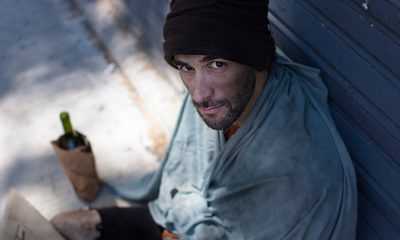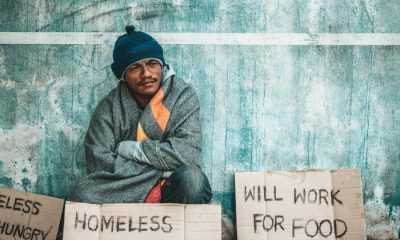Community News
Brain Health Canada and RBC address crisis around youth mental health
Published
3 years agoon
By
Paul Junor
BY PAUL JUNOR
Mental health experts and advocates have recognized that there is a crisis in Canada with respect to youth mental health. This was revealed in an article published in the Globe and Mail (October 7th, 2021). Dr Tamara Vanderwal, a Vancouver-based child psychiatrist has worked tirelessly to help paediatric patients who are faced with mental health challenges. “I have this unique position where I’m both providing care, and understanding what children and families are dealing with along with figuring out the underlying causes.”
In her work with children, she knows first-hand the challenges of trying to understand how psychiatric illnesses develop and how to treat them effectively. She states, “We’re still landing on the moon. There is a huge gap that we’re trying to close in understanding mental health, we need to figure out the basics.”
Dr Catherine Ferland, who works with the non-profit foundation Brain Health, acknowledges the seriousness of the mental health crisis among youth. She states, “Half of the mental health burden is in Canadians aged 15 to 29.” This has been exacerbated due to the COVID-19 pandemic, which resulted in higher levels of depression, anxiety and mental health problems in young people. This will undoubtedly get worse if left untreated among youth, as they get older.
Dr Ferland notes, “There is an actual crisis in society when we talk about mental health. It is a critical time to act.” It is because of the urgency of this youth mental health crisis that Brain Health Canada, and RBC Foundation on Youth Mental Health have joined together to provide financial support for a research competition to develop a new mental health platform.
Dr Viviane Poupon, President and CEO of Brain Health also spoke to the work they are doing,
“We are making a powerful call to action to the research community. This research program is an opportunity for new and emerging approaches to collaborate, develop and share solutions for today’s youth mental health challenges. We must ensure we are equipped to meet the rising demand for youth mental health resources, services and treatment options.”
This program will involve the accumulation of scientific information about youth mental health and the development of a national data bank that will have materials accessible to clinicians, researchers, social workers, and caregivers. Furthermore, there will be attempts to foster collaboration and interaction with diverse research groups and the utilization of a translation expert to put together interpret research in order to enhance accessibility.
Mark Beckles, Vice-President, Social Impact and Innovation, RBC states,
“Our commitment to youth mental well-being is focused on prevention and early intervention programs that support young people with access to knowledge, support and care, when and where they need it. Through our partnership with Brain Canada, RBC Future Launch will help address the barriers often faced by young people when trying to access the mental health support they need.”
Dr Vanderwall is optimistic that this research will provide vital information that will determine the best psychiatric treatment for young psychiatric patients. She states, “It will tell us what they need and how they will do it. For the kids who receive treatment, it will make a huge difference, and it will help us allocate resources in a much more efficient way.”
With a last name that means “Faithful and loyal,” it is no wonder that Paul Junor has become a welcomed addition to the Toronto Caribbean Newspaper Team. Since 1992, Paul has dedicated his life to become what you call a great teacher. Throughout the years, he has formed strong relationships with his students and continues to show them that he cares about them as people. Paul is a warm, accessible, enthusiastic and caring individual who not only makes himself available for his students, but for his community as well.

You may like
-


The Cancer Epidemic – Cancers among young adults have become a global health crisis; Why is that?
-


Super Chic Toronto Fashion Week 2024 ignites the runway with bold collections and fresh talent
-


Chocolate Lovers: you might have to start rationing your chocolate intake
-


Why do elected officials hesitate to do the right thing?
-


Before we allow more people into the country, shouldn’t we prioritize the well-being of our citizens first?
-


Ontario launches One Fare Program to increase accessibility and affordability of public transportation
Community News
The Cancer Epidemic – Cancers among young adults have become a global health crisis; Why is that?
Published
49 seconds agoon
May 5, 2024
BY SIMONE J. SMITH
I remember when cancer was something distant, something that happened to other people, but now, it feels like it’s everywhere. I think everyone knows someone who’s been affected by cancer. It’s become a part of our reality, a very sad reality.
Cancer is one of the most dreaded diseases of the 21st century. A hundred years ago, cancer was not so common; however, since the last couple of decades, its incidence has been rising alarmingly.
What is cancer? Put simply; cancer is the abnormal growth of cells. Cancers arise from any organ, or body structure and are composed of tiny cells that have lost the ability to stop growing. Transformation of a normal cell into a cancerous cell is probably not such a critical event in the genesis of cancer; rather it is the inability of immune cells of the body to identify and destroy the newly formed cancer cells when they are few in numbers. The risk of cancer is multiplied in people whose immune system is suppressed due to any factor including chronic stress, old age, or a chronic debilitating disease.
According to a recent Wall Street Journal analysis of data from the National Cancer Institute, one in five new colorectal cancer patients in the United States is under 55, That’s nearly twice the rate in 1995.
While deaths for colorectal cancer patients over 65 are going down, deaths among younger patients are increasing, a reflection of the higher mortality rates often observed in early-onset cancers. Scientists say these cancers can be more deadly because they are not caught early enough for successful interventions (colonoscopies are not recommended until age 45).
There are several hypothesis for the increase in cancer; one claim is that the increase in global obesity rates since the mid-1990s plays a significant role in the uptick, and scientists have found that specific diets, such as those rich in so-called ultra-processed foods, have been associated with a higher risk of GI cancers, regardless of a person’s body-mass index.
The increase in early-onset cancers has become undeniable, replicated in study after study. A BMJ article published last year found that the early onset of 29 different cancers, including: breast, stomach, and colorectal, had risen nearly 80% between 1990 and 2019 worldwide. Another study published in JAMA Network Open last August found that the occurrence of a wide range of cancers among people under 50 had increased between 2010 to 2019 among American adults, particularly among women.
John Marshall, Director of the Ruesch Center for the Cure of Gastrointestinal Cancers at Georgetown University, has been treating patients for 30 years. Early in his career, he says, he would never have a patient under the age of 50. Today, half of his patients are in that younger cohort, many of them otherwise healthy and fit. He first started to notice the trend with colorectal cancers, but later found an increase in other cancers as well, which significantly mirrors the research literature.
Findings have also pointed to another revelation: “We have, each of us, different risks depending on when we are born,” Shuji Ogino, a Molecular Pathological Epidemiologist at Harvard Medical School, shared in his research.
According to a paper published last year by a New Zealand research team, the upticks in cancers among young adults matched the timeline that we would expect from the multiplication of microplastics in the environment. Research on cellular and rodent models has suggested that microplastics (plastic bottles, packaging, synthetic textiles, cosmetics, and industrial processes) could promote tumor growth. Yeah, pretty much everything that has become commonplace in our lives. Though more research is needed, we already know these materials contain chemicals that can disrupt hormones and pose a risk to our health.
“People born in the first half of the 20th century had a lower risk of developing cancer by age 50 than people born in the second half,” Shuji shares. Other scientists increasingly suspect that exposure to risk factors at certain ages — whether: in utero, early childhood, or early adulthood. — could be playing an important role in a person’s risk of developing cancer at a young age.
Then, there are some other less researched reasons that have been illuminated. According to a recent peer-reviewed analysis, it was discovered that COVID-19 vaccines can trigger genetic changes in cancer patients that could aid in the further development of the disease in such individuals.
The review, published in the Cureus medical journal on December 17th, 2023, looked at the relationship between COVID-19 vaccines and cancer. A review of multiple studies led the authors to conclude that certain COVID-19 vaccines may create an environment that predisposes some cancer patients, including survivors, to “cancer progression, recurrence, and/or metastasis.”
The conclusion was based on two factors. First is the “multi-hit hypothesis” of cancer, which suggests that cancer is the consequence of several genetic mutations. The second is the “growing evidence and safety reports” in the Vaccine Adverse Effects Report System (VAERS), which suggested that some cancer patients who took COVID-19 vaccines saw their conditions worsen.
“In light of the above and because some of these concerns also apply to cancer patients infected with SARS-CoV-2, we encourage the scientific and medical community to urgently evaluate the impact of both COVID-19 and COVID-19 vaccination on cancer biology and tumor registries, adjusting public health recommendations accordingly,” the review said.
Let’s talk about why and how this is happening. MRNA vaccines have the potential to trigger a set of biological mechanisms that could lead to the progression of cancer. These effects are attributed to factors like the “pro-inflammatory action” of lipid nanoparticles (LNPs) and tumor-causing effects of the vaccines’ antigens, namely the spike protein. LNPs are nanoparticle drug delivery systems that can be used to deliver DNA and mRNA into a body. Researchers found that the spike protein, found on the surface of the COVID-19 virus, facilitates the entry of the virus into healthy cells.
The authors who wrote the review are Raquel Valdes Angues from the Oregon Health and Science University School of Medicine in Portland and Yolanda Perea Bustos from the education department in the Government of Catalonia, Barcelona, Spain. They declared that they received, “No financial support” from organizations that might have an interest in their work, and they were involved in no other relationships, or activities that could have influenced the review.
Now, let’s turn to another undiscussed factor; 5G. In an article titled “Health risks from radiofrequency radiation, including 5G, should be assessed by experts with no conflicts of interest,” (Lennart Hardell, and Michael Carlberg), the researchers appealed to the European Union (EU) in September 2017. Their appeal (endorsed by >390 scientists and medical doctors), requested a moratorium on 5G deployment until proper scientific evaluation of potential negative consequences has been conducted.
This request was not acknowledged by the EU. The evaluation of RF radiation health risks from 5G technology was ignored in a report by a government expert group in Switzerland, and a publication from The International Commission on Non-Ionizing Radiation Protection. Conflicts of interest and ties to the industry seem to have contributed to the biased reports. In the report, they note that the lack of proper unbiased risk evaluation of the 5G technology places populations at risk. They also note that there seems to be a cartel of individuals monopolizing evaluation committees, thus reinforcing the no-risk paradigm.
To bring relevance to those thoughts, I discovered an open editorial titled “Moskowitz: Cellphone radiation is harmful, but few want to believe it,” by Anne Brice. For more than a decade, Joel Moskowitz, a researcher in the School of Public Health at UC Berkeley, and Director of Berkeley’s Center for Family and Community Health, has been on a quest to prove that radiation from cellphones is unsafe, but, he said, “Most people don’t want to hear it.”
“People are addicted to their smartphones. We use them for everything now, and, in many ways, we need them to function in our daily lives. I think the idea that they’re potentially harming our health is too much for some people.”
“Cellphones, cell towers and other wireless devices are regulated by most governments,” said Moskowitz. “Our government, however, stopped funding research on the health effects of radiofrequency radiation in the 1990s.”
Since then, he said, research has shown significant adverse biologic and health effects — including brain cancer — associated with the use of cellphones and other wireless devices. And now, he said, with the fifth generation of cellular technology, known as 5G, there is an even bigger reason for concern.
The International EMF Scientist Appeal, signed by over 250 scientists with extensive research backgrounds, underscores a growing concern regarding the health effects of non-ionizing electromagnetic fields emitted by wireless devices like cell phones. With over 2,000 published papers and letters in professional journals, these scientists advocate for health warnings and stronger exposure limits. Their research, spanning numerous animal toxicology studies, indicates a potential for increased oxidative stress, including free radicals, stress proteins, and DNA damage.
A comprehensive 2009 review published in the Journal of Clinical Oncology, suggests a link between heavy cellphone use and heightened brain cancer incidence.
I want to take a moment to highlight the fact that they have attempted to blame many things for the uptick in cancer diagnosis and have ignored two major factors: the introduction of a vaccine, and fifth generation cellular technology. I liken it to the actions of the telecom industry; the comparison to the tobacco industry is striking. Just as tobacco companies once enlisted doctors and dentists to downplay smoking risks in the 1940’s, the telecom industry now utilizes a nuclear physicist to reassure policy makers of the safety of microwave radiation. This pattern echoes the tactics employed by Big Tobacco and underscores the telecom industry’s considerable economic and political influence, surpassing even that of its predecessor.
It appears that we are going to be witnessing more and more cancer diagnosis, especially of people who are much younger. This article was meant to inform and educate; I hope that you utilize this information to ensure that you take all precautions when it comes to your health. You have to care about you, because the powers that be do not!
REFERENCES:
https://www.ncbi.nlm.nih.gov/pmc/articles/PMC9885170/
https://pubmed.ncbi.nlm.nih.gov/36739075/
https://bmcprimcare.biomedcentral.com/articles/10.1186/s12875-023-01967-0
https://www.wsj.com/health/healthcare/cancer-young-people-doctors-baffled-49c766ed
https://www.saferemr.com/2017/09/5g-wireless-technology-is-5g-harmful-to.html
https://www.ncbi.nlm.nih.gov/pmc/articles/PMC7405337/
https://news.berkeley.edu/2021/07/01/health-risks-of-cell-phone-radiation/
https://www.thelancet.com/journals/lanpub/article/PIIS2468-2667(18)30267-6/fulltext
https://jamanetwork.com/journals/jamanetworkopen/fullarticle/2808381
https://bmjoncology.bmj.com/content/2/1/e000049#DC1
https://www.bmj.com/content/378/bmj-2021-068921
Community News
Super Chic Toronto Fashion Week 2024 ignites the runway with bold collections and fresh talent
Published
7 mins agoon
May 5, 2024By
TOCaribNews
BY RUSHANE FERRON
The guru always echoing the mantra “Life Is Too Short to Wear Boring Clothes!”, the Super Chic Toronto Fashion Week held at the Toronto Don Valley Hotel on April 15th, turned a typical Sunday into a spectacular affair of style and creativity. The event, highlighted the vibrant colours and innovative designs, showcased the much-anticipated 2024 spring collections from renowned fashion houses Bella Fashion Designs, Francesca Milano, Bindi Fashion Design, and Ohhh So Swag, offering an exhilarating preview of the trends set to dominate the seasons.
Founded by the Florida-based Bella Fashion Designs, Super Chic Fashion Week has evolved into a significant platform uniting both burgeoning and established designers, models, and creatives from across the globe. The Toronto event marked one of 24 annual showcases organized by Super Chic, stretching across the Americas and Europe. According to Rachel Marvilli, Chief Financial Officer of Super Chic Fashion Week, the event aims to boost brand recognition while providing a dynamic stage for artistic expression. “Our shows are more than just catwalks; they’re about choreography, innovation, and setting trends,” Marvilli emphasized during the event.
This year’s runway sizzled with the energy of approximately 40 models, bringing to life the designers’ visions for not only women’s wear but also men’s and children’s fashion. The collections ranged from everyday chic to sophisticated elegance, ensuring a style for every occasion and echoing the diverse, cosmopolitan spirit of Toronto itself.
Kevon Campbell, an international model who has been with Super Chic for over a year, shared his exhilarating experience. “Each piece I wear is a reflection of my personality; it’s about more than fashion—it’s about building confidence and pushing boundaries,” he stated, affirming the personal growth and exposure the platform has afforded him.
Newcomer Brianna Bovdot also expressed her delight with the inclusivity and excitement of her first runway show. “It was an amazing opportunity to connect, learn, and truly embrace the modeling world. I felt right at home with every step I took on that runway,” Bovdot remarked, hinting at her aspirations to turn modeling into a full-time career.
Further adding to the unique flair of the event, Sancia Thompson, CEO of Ohhh So Swag, shared her brand’s philosophy, rooted in confidence, music, and faith. Having transitioned from a career in law to fashion, Thompson’s story is a testament to following one’s passion, a message she hopes to embed within every piece of her collection. “This show is a crucial step for gaining exposure and connecting deeply with my audience,” she explained.
As Super Chic Fashion Week continues to innovate and expand, the next stops are Miami and Toronto for the summer, promising to unveil an enticing array of resort and swimwear. Toronto’s fashion enthusiasts and the global community alike eagerly anticipate these upcoming events, ready to embrace new trends and celebrate the relentless spirit of creativity and style that Super Chic Fashion Week champions.
For fashion aficionados unable to attend the show, pieces from the collections will be available at Bella Fashion Design’s showroom in South Florida, with options catering to various budgets, ensuring everyone can partake in the joy and confidence that comes with great fashion.
Stay tuned, as the journey of style continues to unfold, promising more surprises, more breakthroughs, and of course, more fabulous fashion. Additional information can be obtained at www.bellafashiondesignsshop.com or on their social media platforms.
Community News
Chocolate Lovers: you might have to start rationing your chocolate intake
Published
10 mins agoon
May 5, 2024
BY SIMONE J. SMITH
I stood with a friend in the chocolate aisle, staring at the shelves filled with various chocolate products. A price tag caught my eye, “Look at this, girl!” My friend took a look, and instantly, her expression mirrored mine.
“Unbelievable. It’s like daylight robbery!” I reluctantly picked up a smaller bar of chocolate, clearly debating whether it’s worth the higher price. “Yeah, it’s crazy! I used to buy chocolate bars without a second thought, but now…”
Did you guys notice how expensive those chocolate eggs were this Easter? Absolutely! Many had to cut back on how much they bought for their children. I have even heard parents talking about adjusting their budgets for next Easter. If you can believe it, the rising cost of chocolate is actually putting a strain on finances, amongst everything else.
North Americans and Europeans noticed the uptick around Easter, when the prices of popular chocolate products were up as much as 50%. Some analysts suggest chocolate may end up a luxury product, at least for the near future, as sellers like Hershey (Oh no! I love my Kisses) and Mondelez raise prices.
In March, cocoa futures reached 12k per kilogram, or 12m naira per metric ton (~$9.6k), more than three times its price in the last quarter of 2023 and nearly five times more than in the last quarter of 2022.
For farmers in West Africa, where the majority of the globe’s cocoa is grown, the higher prices have been a mixed blessing. While rejoicing over the soaring rates, they’ve been held back by severe weather, rising rents, and government price regulations. Some farmers have invested in their farms, hoping the record prices will continue for this fall’s harvest.
In 2022, Russia’s invasion of Ukraine led to roughly half of Europe’s fertilizer production going dormant. Fertilizers became cost-prohibitive to most West African farmers who stopped using fertilizer completely.
At the same time, radical weather patterns didn’t help. El Niño brought heavy rainfall followed by heat and drought, which absolutely devastated cacao trees. Cacao trees grow fruits called pods that are filled with cocoa seeds (or beans) that can be processed into chocolate.
By early 2024, months after the fall harvest, it became clear farmers had far fewer crops than normal. Compared to the originally predicted output for the 2023-24 season, cocoa production is expected to fall by:
- 40% in Ghana
- 30% in Nigeria
In Côte d’Ivoire, the first quarter output this year was 29% lower than the same period in 2023. One farmer in Nigeria ended up yielding two metric tons of cocoa last year, about one metric ton less than normal. “You work the same, the trees just yield less,” Olowolagba Rafiu shares.
In 2023, cocoa sold at an estimated 50% more than it had the year before in Nigeria, but the increase wasn’t enough to protect farmers from the country’s severe inflation and economic malaise. By the time farmers are done tending to expenses and getting ready for a new growing season, many of them do not have any expendable income left.
Countries like Cameroon and Ghana set fixed prices for cocoa farmers called farm gates. When prices are low, these measures help protect farmers, most of whom do not earn a living wage in Ghana. The farm gates were set before the market spiked, with prices for farmers in those countries at about one-third of what cocoa fetches on the open market.
On top of that, rent and property rates have increased.
In the past years, Olowolagba Rafiu has paid an annual rent of 150k naira (~$120) on three hectares of farmland. This year, his landlords asked for 500k naira, and he was able to negotiate down to 350k. Baba typically pays a tax of 30k naira on his land; this year he’ll be paying over 100k naira.
To add to the drama, during last year’s harvest season, theft got so bad that farmers in some communities set up security task forces to prevent pods from being stolen directly on trees in the forests. Some farmers would come out to their fields in the rising and find all your trees stripped bare.
I know, right? I might have to start rationing my chocolate intake.
REFERENCES:
https://www.linkedin.com/pulse/high-cocoa-prices-unsustainable-especially-people-who-jxube/

The Cancer Epidemic – Cancers among young adults have become a global health crisis; Why is that?

Super Chic Toronto Fashion Week 2024 ignites the runway with bold collections and fresh talent

Chocolate Lovers: you might have to start rationing your chocolate intake

Why do elected officials hesitate to do the right thing?

Before we allow more people into the country, shouldn’t we prioritize the well-being of our citizens first?

Ontario launches One Fare Program to increase accessibility and affordability of public transportation
YOGA: Surya Namaskar (Sun Salutation) for sufferers of hypertension or heart disease
Kemtek Development launches new exclusive gated community in Jamaica!

Ravi’s West Indian Grocery – Fresh Products Weekly Straight from Guyana!

Tourism-Related Live Streaming – The Manifold Ways it Can Create a Buzz for a Destination

ASA Meats & West Indian Groceries – Serving Freshness & Quality to the Community

Do You Have a 407 ETR Story?

Nadine Sutherland – A woman who continues to reinvent herself

Knia Singh – Light Up The Darkness

Spragga Benz – Light Up The Darkness

Kyle Kemper – Light Up The Darkness

David Icke – Light Up The Darkness

Ohio’s Bill 248 and Dr. Sherri Tenpenny’s compelling testimony
Trending
-

 Junior Contributors1 week ago
Junior Contributors1 week agoBeneath the waves: Unveiling the legacy of the transatlantic slave trade in the Bahamas
-

 Community News1 week ago
Community News1 week agoStep into Spring with SheaMoisture’s new collection
-

 Community News6 days ago
Community News6 days agoThe Federal Government has created Personal Information Banks (PIB) to collect and store data on Canadians
-

 Community News6 days ago
Community News6 days agoUnder the radar; Manitoba principal apologizes for the distribution of sex education kits
-

 The Poetic Word1 week ago
The Poetic Word1 week agoEverlasting Flames-to be Submitted
-

 Community News6 days ago
Community News6 days agoHOV presents “CANNABIS, HERSTORY!” incorporating cannabis back into our stories
-

 Community News6 days ago
Community News6 days agoA stable economic-political world is a sound goal, but at what cost to America?
-

 Community News4 days ago
Community News4 days agoOntario launches One Fare Program to increase accessibility and affordability of public transportation





